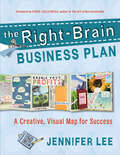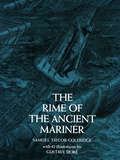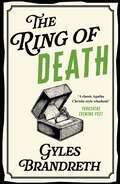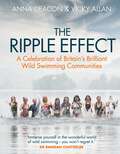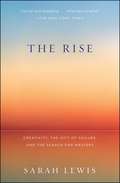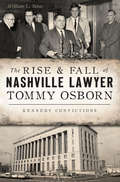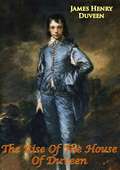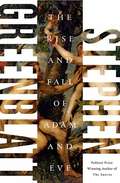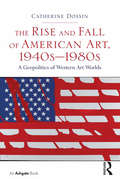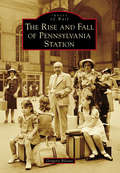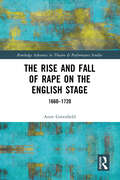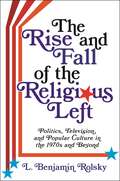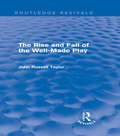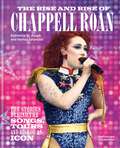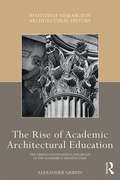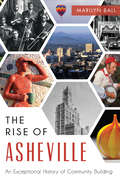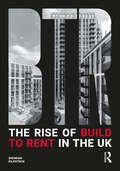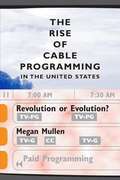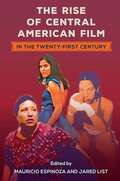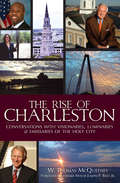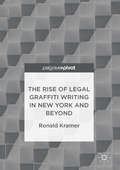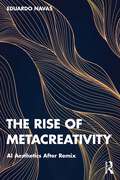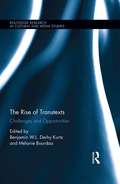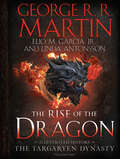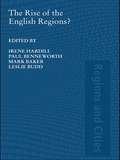- Table View
- List View
The Right-Brain Business Plan: A Creative, Visual Map for Success
by Jennifer LeeMillions of artists, entrepreneurs, crafters, and solopreneurs dream of making a living doing what they love. But turning their vision into a viable business plan can feel like trying to fit a square peg into a round hole. Jennifer Lee knows what it’s like to make the entrepreneurial leap — and how to do it successfully. The key is showing creative types how to use — rather than stifle — the imagination and intuition that make them creative in the first place. Lee’s illustrated, colorful worksheets and step-by-step instructions are playful yet practical, enabling readers to get down to the essential business of defining their vision and nailing down plans for funding, marketing, networking, and long-term strategy. Both budding and seasoned business owners will benefit from Lee’s wonderfully original approach. Discover how to: • Develop a financial plan with fun and flair • Select your circle of support to get the work done • Clarify your business values and goals • Paint a picture of your business landscape • Understand your competition and what makes you stand out from the crowd • Identify your perfect customers and create a marketing plan to reach them • Map out concrete action steps to bring your Right-Brain Business Plan to life
The Rime of the Ancient Mariner
by Gustave Doré S. T. ColeridgeGustave Dore's magnificent engravings for The Rime of the Ancient Mariner are among the later works of the great French illustrator. The intensely evocative poem provided Doré with the long-awaited opportunity to convey limitless space on a gigantic scale, and he exploited the poem's fantastic range of atmosphere to the limits of its possibilities. The terrifying space of the open sea, the storms and whirlpools of an unknown ocean, the vast icy caverns of Antarctica, the hot equatorial sea swarming with monsters, all of the amazing visual elements that make Coleridge's masterpiece one of the most exciting and most memorable poems in the English language are unforgettably engraved in Doré's plates.This edition reproduces all of the plates to perfection, in their original size. The illustrations and the text of the poem appear on facing pages, so that the imaginative kinship of Doré and Coleridge is delightfully evident on every page: the illustrations capture all the moods of the poem in their full intensity, bringing the images evoked by the words into clear visual focus. Unabridged and slightly rearranged republication of the 1878 American edition. Text slightly amended to conform to the authoritative 1834 edition of the poem.
The Ring of Death: The Victorian Murder Mystery Series: 2 (The Victorian Murder Mystery Series #2)
by Gyles Brandreth'So amazingly good, I could not put it down' Reader review ⭐⭐⭐⭐⭐'An inventive and highly enjoyable murder mystery' Reader review ⭐⭐⭐⭐⭐Will a game of Murder at a dinner party turn deadly?London 1892: Author Oscar Wilde has assembled friends and acquaintances for one of his Sunday Supper Clubs, among their number is his great friend and creator of Sherlock Holmes, Arthur Conan Doyle. Mid-way through the evening, a game is proposed: each guest must write down the name of the person they would most like to kill.But soon, the fictional victims begin to die one-by-one in mysterious circumstances - in the order their names were drawn during the game.With growing horror, Wilde and Doyle realise that one of their guests must be the murderer. Trapped in a race against time, they must uncover the killer's identity before they can complete their final move . . .A wonderfully witty and addictive cosy historical mystery that presents the reader with an intricate puzzle to solve. Perfect for fans of Sherlock Holmes, Agatha Christie and Richard Osman.Readers are gripped by The Ring of Death:'Crackles with wit, tension, mysteries, and is reminiscent (but dare I say better) than the Sherlock Holmes canon' Reader review ⭐⭐⭐⭐⭐'Oscar Wilde is solving crimes while rubbing elbows with Sir Arthur Conan Doyle . . . What's not to like?' Reader review ⭐⭐⭐⭐⭐'This book had everything I love in a story: historical detail, cleverness, wonderful conversational by-play . . . BRAVO!' Reader review ⭐⭐⭐⭐⭐
The Ripple Effect: A Celebration of Britain's Brilliant Wild Swimming Communities
by Anna Deacon Vicky AllanA Beautifully Photographed Swimming Book“Immerse yourself in the wonderful world of wild swimming - you won't regret it.” -Dr. Rangan ChatterjeeDive into the wonderful world of wild swimming with a series of photographs by Anna Deacon that captures the wonderful world of diving.Forging friendships in the water. Enter the world of aquatics and learn about the community of swimmers that Britain’s wild swimming creates. Wild swimming isn’t just a pastime; it’s an ocean of connection that attracts swimmers across Britain and draws people from all walks of life to dive deep and find inspiration in the water.A swimmer’s paradise. The Ripple Effect showcases all types of swimmers. From fans of the wim hof method to those who want to take their swimming exercises to the open water, this book of aquatic photography is the perfect gift for swimmers.More than just pictures. Anna Deacon offers a community to connect. With visually stunning photographs depicting wild swimmers in Britain’s natural aquatic habitats, you’ll feel just as eager to go diving for your own wild adventure.Inside, you’ll find: Authentic photography showcasing an array of wild swimming communitiesSwimming stories that inspire, encourage, and laughThe wonderful world of wild swimming and why it’s so popular in BritainIf you liked Shaping Surf History, Comp, or Women Making Waves, or Winter Swimming, you’ll love The Ripple Effect.
The Rise
by Sarah LewisIt is one of the enduring enigmas of the human experience: many of our most iconic, creative endeavors--from Nobel Prize-winning discoveries to entrepreneurial inventions and works in the arts--are not achievements but conversions, corrections after failed attempts. The gift of failure is a riddle. Like the number zero, it will always be both a void and the start of infinite possibility. The Rise--a soulful celebration of the determination and courage of the human spirit--makes the case that many of our greatest triumphs come from understanding the importance of this mystery. This exquisite biography of an idea is about the improbable foundations of creative human endeavor. The Rise begins with narratives about figures past and present who range from writers to entrepreneurs; Frederick Douglass, Samuel F. B. Morse, and J. K. Rowling, for example, feature alongside choreographer Paul Taylor, Nobel Prize-winning physicists Andre Geim and Konstantin Novoselov, Arctic explorer Ben Saunders, and psychology professor Angela Duckworth. The Rise explores the inestimable value of often ignored ideas--the power of surrender for fortitude, the criticality of play for innovation, the propulsion of the near win on the road to mastery, and the importance of grit and creative practice. From an uncommonly insightful writer, The Rise is a true masterwork.
The Rise & Fall of Nashville Lawyer Tommy Osborn: Kennedy Convictions (True Crime)
by William L. TabacTommy Osborn's star was rising. The young Nashville lawyer led a band of Tennessee reformers to victory in a landmark Supreme Court case. Hailed by Chief Justice Earl Warren as the most important of his career, Baker v. Carr's "one man, one vote" mandate revolutionized how Americans chose their representatives. Osborn was hired by Jimmy Hoffa to take on Bobby Kennedy for the fourth time. Unfortunately, the young lawyer met his match in Walter Sheridan, Kennedy's top aide and brilliant spymaster. Author William L. Tabac describes the extraordinary legal proceeding with the twists and turns of a modern television drama and the fall of a prominent attorney.
The Rise Of The House Of Duveen
by James Henry DuveenThis book provides an exciting portrayal of the history of the Duveen family in the art business up to 1939."THOUGH MANY REASONS have contributed to impel me to write this hook, the chief one is the memory of my uncle Joel Joseph Duveen. On the death of my father at the untimely age of twenty-nine, when I was four years old, my uncle was appointed my guardian by the Dutch court. He took a constant interest in me as I grew up; and, seeing how much I admired his energy and brilliance, he loved to tell me his interesting experiences. I was an eager listener and made notes of all he told me. He frequently invited me to accompany him on long journeys, and I spent many holidays with him on the Continent; the most pleasurable and exciting parts of these travels with him were the stories of his early life and the reminiscences of his business career."A friend [...] sent me in 1954 a fascinating book, Duveen, by S. N. Behrman, a gifted American author, which I read with the greatest interest. In it he has produced a brilliant picture of Lord Duveen's character and methods, and he is to be congratulated on his successful portrait. But this exciting book is chiefly concerned with the period of Lord Duveen; and I am grateful to its author for inspiring me to take up my pen again and place on record the greatness of the older generation who, by more brilliant but less grandiose methods, created the firm Lord Duveen raised to a height that may never again be equalled."I therefore began [...] to set down my memories of a line of great and intrepid connoisseurs in art. In our careers the art treasures in which we dealt and the great figures who formed our clientele are more interesting than we are ourselves. For this reason I have tried to picture the characters of my family by their adventurous dealings rather than by long biographical sketches; the incidents related are authentic in all details except names, some of which have been disguised for obvious reasons."
The Rise and Fall of Adam and Eve
by Stephen GreenblattStephen Greenblatt, the National Book Award- and Pulitzer Prize-winning author, investigates the life of one of humankind's greatest stories. The Rise and Fall of Adam and Eve explores the enduring story of humanity's first parents, and through them, of Western civilization. Greenblatt explores the tremendous theological, artistic, and cultural creativity over the centuries that made Adam and Eve so profoundly resonant, and continues to make them, finally, so very "real" to millions of people even in the present. Be sure to read the photo captions which are placed after the Index as these are especially interesting in this book. Greenblatt gives equally full coverage to both believers and skeptics.
The Rise and Fall of American Art, 1940s–1980s: A Geopolitics of Western Art Worlds
by Catherine DossinIn The Rise and Fall of American Art, 1940s-1980s, Catherine Dossin challenges the now-mythic perception of New York as the undisputed center of the art world between the end of World War II and the fall of the Berlin Wall, a position of power that brought the city prestige, money, and historical recognition. Dossin reconstructs the concrete factors that led to the shift of international attention from Paris to New York in the 1950s, and documents how ’peripheries’ such as Italy, Belgium, and West Germany exerted a decisive influence on this displacement of power. As the US economy sank into recession in the 1970s, however, American artists and dealers became increasingly dependent on the support of Western Europeans, and cities like Cologne and Turin emerged as major commercial and artistic hubs - a development that enabled European artists to return to the forefront of the international art scene in the 1980s. Dossin analyses in detail these changing distributions of geopolitical and symbolic power in the Western art worlds - a story that spans two continents, forty years, and hundreds of actors. Her transnational and interdisciplinary study provides an original and welcome supplement to more traditional formal and national readings of the period.
The Rise and Fall of Pennsylvania Station (Images of Rail)
by Gregory BilottoThe construction of Pennsylvania Station (1904-1910) was a monumental undertaking equally for the voluminous earth displaced, incredible innovation, and brilliant French-influenced classical architecture, but it also was a quintessential archetype of the Gilded Age. The station reshaped the economic and social fabric of New York by dislodging scores of families and local businesses. It had been built for prestige and grandeur rather than sustainability and prolonged the rivalry with the New York Central and Hudson River Railroads, leading to the creation of Grand Central Terminal. Although the station was successful for increasing passenger journeys, the rise of independent travel after World War II and mounting financial losses culminated with its unfortunate demise and eventual destruction. Nevertheless, through the misfortune of demolition emerged the first historic preservation laws, which have saved countless historic buildings, including its Park Avenue rival.
The Rise and Fall of Rape on the English Stage: 1660–1720 (ISSN)
by Anne GreenfieldThis book examines one of the most pervasive and successful dramatic tropes of the Restoration and early eighteenth century: sexual violence.During this sixty-year span, there were over fifty tragic and tragi-comedic productions that showcased rape and/or attempted rape—a remarkable number that was unprecedented in English dramatic history. Rape was not merely depicted more frequently during the Restoration, but it was also placed at the center of more plots, given more pathetic emphasis, and even staged more centrally. Restoration dramatists were the first to revolve routinely entire plots around the rapes of their innocent heroines, to give powerful voices to these heroines post-rape, and to imbue their sexually violent scenes with new and attention-getting staging techniques, such as discovery scenes. As this book argues, sexual violence emerged at this time as a highly flexible dramatic trope that could be used to illustrate terrifying political scenarios, elicit extreme pathos in audiences, and demonstrate the bearing that lost chastity had on social stability. It is precisely the rich, multi-faceted appeal of these productions—politically, sexually, visually, and culturally—that explains the popularity and significance of this dramatic trope on the English stage.This book will be of interest to students and scholars in Restoration, eighteenth-century studies, and theatre and performance studies.
The Rise and Fall of the Religious Left: Politics, Television, and Popular Culture in the 1970s and Beyond (Columbia Series on Religion and Politics)
by L. Benjamin RolskyFor decades now, Americans have believed that their country is deeply divided by “culture wars” waged between religious conservatives and secular liberals. In most instances, Protestant conservatives have been cast as the instigators of such warfare, while religious liberals have been largely ignored. In this book, L. Benjamin Rolsky examines the ways in which American liberalism has helped shape cultural conflict since the 1970s through the story of how television writer and producer Norman Lear galvanized the religious left into action.The creator of comedies such as All in the Family and Maude, Lear was spurred to found the liberal advocacy group People for the American Way in response to the rise of the religious right. Rolsky offers engaged readings of Lear’s iconic sitcoms and published writings, considering them as an expression of what he calls the spiritual politics of the religious left. He shows how prime-time television became a focus of political dispute and demonstrates how Lear’s emergence as an interfaith activist catalyzed ecumenical Protestants, Catholics, and Jews who were determined to push back against conservatism’s ascent. Rolsky concludes that Lear’s political involvement exemplified religious liberals’ commitment to engaging politics on explicitly moral grounds in defense of what they saw as the public interest. An interdisciplinary analysis of the definitive cultural clashes of our fractious times, The Rise and Fall of the Religious Left foregrounds the foundational roles played by popular culture, television, and media in America’s religious history.
The Rise and Fall of the Well-Made Play (Routledge Revivals)
by John Russell TaylorFirst published in 1967, this title considers the idea of the ‘well-made play’ in the context of how and why it has been devalued and how far, in allowing it to be devalued, we have lost sight of certain important elements of the theatre. The focus of the book is largely on the development of British theatre and those who have been instrumental to it. This is an indispensable introduction for any student with an interest in the history and development of the British theatre.
The Rise and Rise of Chappell Roan: The Stories Behind the Songs, Tours and Rise of an Icon (Stories Behind The Songs, Tours and Rise of an Icon)
by Katherine St. Asaph Hamza Jahanzeb'Jahanzeb and St. Asaph's song-by-song analysis is illuminating. Sparkly, sassy, but with a strong foundation, much like Roan herself.' - Genevieve Williams, Library JournalWELCOME TO THE PINK PONY CLUBThe SONGS, STORIES, PERFORMANCES, FASHION, and FUTURE of your favourite artist's favourite artist.Step into the glitter-dusted world of Chappell Roan with this ultimate insider's guide.From her early demos as Kalyleigh Amustz to the development of her drag persona and the dazzling stages of The Midwest Princess Tour, this guide chronicles her 10-year journey from small-town dreamer to global queer icon.Delve into the inspiration behind chart-topping hits like 'Good Luck, Babe!', 'Pink Pony Club', and 'HOT TO GO!', along with lesser-known tracks and fan favourites. With iconic photography, stunning illustrations, and rare insights into her collaborations with Dan Nigro, Olivia Rodrigo, and Elton John, this book reveals the trials and triumphs that have fuelled her rise.For fans, dreamers, and anyone who's ever felt like an outsider, this is your backstage pass into the mind of an artist who is fearlessly pushing the boundaries of pop music.CHAPPELL ROAN IS REWRITING THE RULES OF POP STARDOM - THIS IS WHERE IT ALL BEGAN.
The Rise of Academic Architectural Education: The origins and enduring influence of the Académie d’Architecture (Routledge Research in Architectural History)
by Alexander GriffinAcademic architectural education started with the inauguration of the Académie d'Architecture on 3 December 1671 in France. It was the first institution to be devoted solely to the study of architecture, and its school was the first dedicated to the explicit training of architectural students. The Académie was abolished in 1793, during the revolutionary turmoil that besieged France at the end of the eighteenth century, although the architectural educational tradition that arose from it was resurrected with the formation of the École des Beaux-Arts and prevails in the ideologies and activities of schools of architecture throughout the world today. This book traces the previously neglected history of the Académie’s development and its enduring influence on subsequent architectural schools throughout the following centuries to the present day. Providing a valuable context for current discussions in architectural education, The Rise of Academic Architectural Education is a useful resource for students and researchers interested in the history and theory of art and architecture.
The Rise of Asheville: An Exceptional History Of Community Building
by Marilyn BallAs newcomers flocked to Asheville over the last fifty years, they joined with locals to breathe new energy into the city. Sometimes called the Asheville One Thousand, these folks didn't necessarily intend to be entrepreneurs, community organizers and business leaders, but when they saw a challenge, they rose to it. Stone Soup became a gathering place and laid the foundation for Asheville's natural food culture. MANNA Food Bank emerged to help solve hunger. And the River Arts District turned into a vibrant cultural center for upcoming artists. Join author Marilyn Ball as she traces the bonds of community that gave rise to Asheville today.
The Rise of Build to Rent in the UK
by Brendan KilpatrickBuild to Rent (BTR) is a form of residential tenure which first emerged in the United States, where it is known as Multifamily Housing. While it has been a mature asset in the United States for over a decade, it is relatively new to the UK and Ireland. The Rise of Build to Rent in the UK examines how this type of housing can play a key role in streamlining design and construction activity in a forward-facing manner which embraces climate change resilience and digital methods for delivery and management within the circular economy. The book examines the background of traditional UK home-owning and renting from which this new sector emerged, and charts BTR’s momentum swing in 2016 and on-going expansion to the present day, describing the potential of the BTR model in terms of both economic and climate sustainability and evaluating the key ingredients to success. The Rise of Build to Rent in the UK concludes with five highly illustrated UK case studies which evaluate the practical deliverability of real world BTR projects. This book will be of interest to BTR operators and investors, constructors, housing associations, municipal authorities and students of architecture and urban planning.
The Rise of Cable Programming in the United States: Revolution or Evolution?
by Megan MullenIn 1971, the Sloan Commission on Cable Communications likened the ongoing developments in cable television to the first uses of movable type and the invention of the telephone. <P><P>Cable's proponents in the late 1960s and early 1970s hoped it would eventually remedy all the perceived ills of broadcast television, including lowest-common-denominator programming, inability to serve the needs of local audiences, and failure to recognize the needs of cultural minorities. Yet a quarter century after the "blue sky" era, cable television programming closely resembled, and indeed depended upon, broadcast television programming. Whatever happened to the Sloan Commission's "revolution now in sight"?
The Rise of Central American Film in the Twenty-First Century (Reframing Media, Technology, and Culture in Latin/o America)
by Mauricio Espinoza Jared ListHow an overlooked film industry became a cinematic force The first book in English dedicated to the study of Central American film, this volume explores the main trends, genres, and themes that define this emerging industry. The seven nations of the region have seen an unprecedented growth in film production during the twenty-first century with the creation of over 200 feature-length films compared with just one in the 1990s. This volume provides a needed overview of one of the least explored cinemas in the world. In these essays, various scholars of film and cultural studies from around the world provide insights into the continuities and discontinuities between twentieth- and twenty-first-century cinematic production on the Isthmus. They discuss how political, social, and environmental factors, along with new production modes and aesthetics, have led to a corpus of films that delve into issues of the past and present such as postwar memory, failed revolutions, trauma, migration, popular culture, minority populations, and gender disparities. From Salvadoran documentaries to Costa Rican comedies and Panamanian sports films, the movies analyzed here demonstrate the region’s flourishing film industry and the diversity of approaches found within it. The Rise of Central American Film in the Twenty-First Century pays homage to an overlooked cultural phenomenon and shows the importance of regional cinema studies.Contributors: Liz Harvey-Kattou | Daniela Granja Núñez | Carolina Sanabria | Juan Carlos Rodríguez | María Lourdes Cortés | Júlia González de Canales Carcereny | Arno Jacob Argueta | Tomás Arce Mairena | Dr. Mauricio Espinoza | Lilia García Torres | Dr. Jared List | Patricia Arroyo Calderón | Esteban E. Loustaunau | Héctor Fernández L'Hoeste | Juan Pablo Gómez Lacayo | Jennifer Carolina Gómez Menjívar A volume in the series Reframing Media, Technology, and Culture in Latin/o America, edited by Héctor Fernández L’Hoeste and Juan Carlos Rodríguez Publication of this work made possible by a Sustaining the Humanities through the American Rescue Plan grant from the National Endowment for the Humanities.
The Rise of Charleston: Conversations with Visionaries, Luminaries & Emissaries of the Holy City
by W. Thomas McQueeneySince its 1670 founding, Charleston has experienced the devastation of wars, economic hardships and natural disasters. And yet, Charlestonians and their city have prevailed through it all. It is in this current generational surge that the Holy City has experienced meteoric success and taken its place on the world stage. This thematic weave of essays drawn from interviews explores those essential personalities who have lifted Charleston to its new perch as a must-see destination--one that is known as the most welcoming and the most recommended in America. Join engaging local author W. Thomas McQueeney in this updated edition as he relays stories of the 1950s, "60s and "70s through the eyes of those who have witnessed Charleston's evolution to become the charming city it is today.
The Rise of Legal Graffiti Writing in New York and Beyond
by Ronald KramerThis pivot analyzes the historical emergence of legal graffiti and how it has led to a new ethos among writers. Examining how contemporary graffiti writing has been brought into new relationships with major social institutions, it explores the contemporary dynamics between graffiti, society, the art world and social media, paying particular attention to how New York City's political elite has reacted to graffiti. Despite its major structural transformation, officials in New York continue to construe graffiti writing culture as a monolithic, criminal enterprise, a harbinger of economic and civic collapse. This basic paradox - persistent state opposition to legal forms of graffiti that continue to gain social acceptance - is found in many other major cities throughout the globe, especially those that have embraced neoliberal forms of governance. The author accounts for the cultural conflicts that graffiti consistently engenders by theorizing the political and economic advantages that elites secure by endorsing strong 'anti-graffiti' positions.
The Rise of Metacreativity: AI Aesthetics After Remix
by Eduardo NavasThis book brings together history and theory in art and media to examine the effects of artificial intelligence and machine learning in culture, and reflects on the implications of delegating parts of the creative process to AI. In order to understand the complexity of authorship and originality in relation to creativity in contemporary times, Navas combines historical and theoretical premises from different areas of research in the arts, humanities, and social sciences to provide a rich historical and theoretical context that critically reflects on and questions the implications of artificial intelligence and machine learning as an integral part of creative production. As part of this, the book considers how much of postproduction and remix aesthetics in art and media preceded the current rise of metacreativity in relation to artificial intelligence and machine learning, and explores contemporary questions on aesthetics. The book also provides a thorough evaluation of the creative application of systematic approaches to art and media production, and how this in effect percolates across disciplines including art, design, communication, as well as other fields in the humanities and social sciences. An essential read for students and scholars interested in understanding the increasing role of AI and machine learning in contemporary art and media, and their wider role in creative production across culture and society.
The Rise of Transtexts: Challenges and Opportunities (Routledge Research in Cultural and Media Studies)
by Benjamin W.L. Derhy Kurtz Mélanie BourdaaThis volume builds on previous notions of transmedia practices to develop the concept of transtexts, in order to account for both the industrial and user-generated contributions to the cross-media expansion of a story universe. On the one hand exists industrial transmedia texts, produced by supposedly authoritative authors or entities and directed to active audiences in the aim of fostering engagement. On the other hand are fan-produced transmedia texts, primarily intended for fellow members of the fan communities, with the Internet allowing for connections and collaboration between fans. Through both case studies and more general analyses of audience participation and reception, employing the artistic, marketing, textual, industrial, cultural, social, geographical, technological, historical, financial and legal perspectives, this multidisciplinary collection aims to expand our understanding of both transmedia storytelling and fan-produced transmedia texts.
The Rise of the Dragon: An Illustrated History of the Targaryen Dynasty, Volume One (The Targaryen Dynasty: The House of the Dragon)
by George R. Martin Linda Antonsson Elio M. GarcíaNEW YORK TIMES BESTSELLER • This lavish visual history—featuring over 180 all-new illustrations—is a stunning introduction to House Targaryen, the iconic family at the heart of HBO&’s Game of Thrones prequel series, House of the Dragon. For hundreds of years, the Targaryens sat the Iron Throne of Westeros while their dragons ruled the skies. The story of the only family of dragonlords to survive Valyria&’s Doom is a tale of twisty politics, alliances and betrayals, and acts both noble and craven. The Rise of the Dragon chronicles the creation and rise of Targaryen power in Westeros, covering the history first told in George R. R. Martin&’s epic Fire & Blood, from Aegon Targaryen&’s conquest of Westeros through to the infamous Dance of the Dragons—the bloody civil war that nearly undid Targaryen rule for good. Packed with all-new artwork, the Targaryens—and their dragons—come vividly to life in this deluxe reference book. Perfect for fans steeped in the lore of Westeros, as well as those who first meet the Targaryens in the HBO series House of the Dragon, The Rise of the Dragon provides a must-have overview for anyone looking to learn more about the most powerful family in Westeros.
The Rise of the English Regions? (Regions and Cities)
by Mark Baker Paul Benneworth Leslie Budd Irene HardillThis book analyzes devolution as it affects the English Regions, working from the perspective of uneven development, and drawing on the rich tradition of regional geography. Currently, London is the power centre ruling over the other English regions. The first part of the book looks at how this regional structure has arisen, and the theories that can be used to analyze it. The contributors discuss the nature of regional problems and governance, the institutions involved in regional governance and regional approaches to economic development. The second part of the book devotes a chapter to each English region, examining each region’s unique characteristics, and the opportunities created for it by devolution. By looking carefully at the regions, this part of the book sheds light on the question of whether Regional governance benefits the regions, or simply rescales governance to introduce another layer of bureaucracy.
